Research and connection bring hope to rare disease patients and families
25. Februar 2022
Von Peter Linsley, Kerry Holland
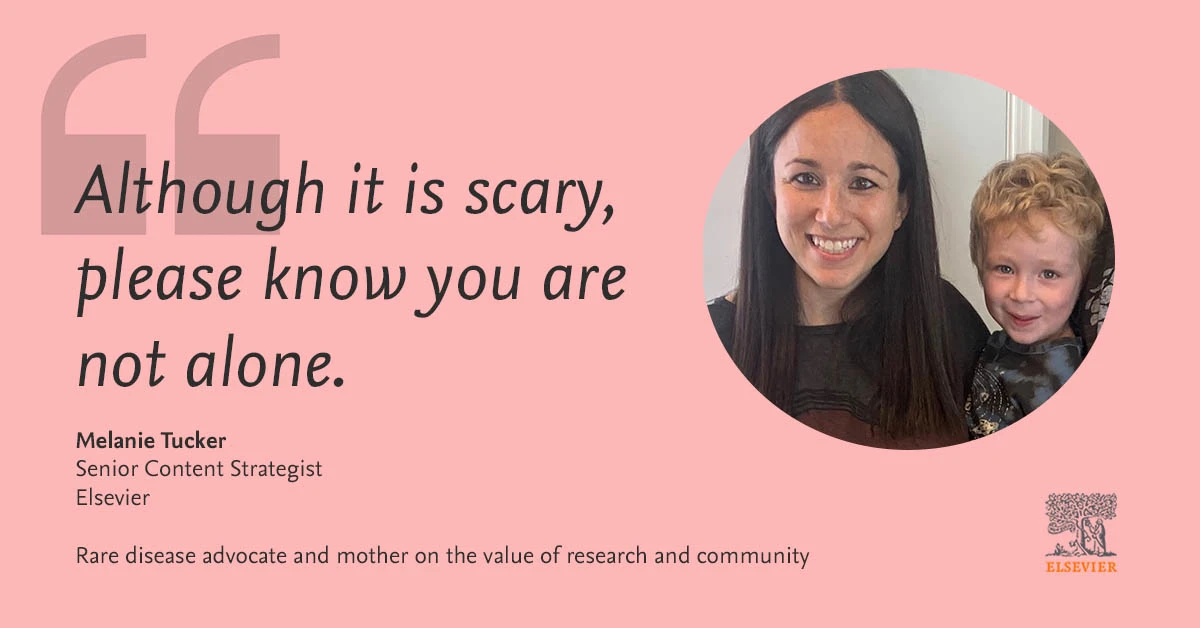
In recognition of #RareDiseaseDay, Elsevier is making select research articles and book chapters freely available for two months
As the mother of a boy with a rare congenital heart defect, Elsevier’s Melanie Tucker talks about the value of community for patients, caregivers and researchers. Melanie is a Senior Content Strategist for Elsevier’s Neurology, Radiology, Psychiatry and Sleep Medicine books program. In her 20th week of pregnancy, Melanie Tucker went for a routine ultrasound. What followed was anything but routine. Melanie and her husband learned of their son’s diagnosis: Tetralogy of Fallot — a complex congenital heart defect that occurs in about 1 in every 3,000 births.
Since his birth, Melanie’s son has undergone multiple surgeries and procedures, and will be followed closely by cardiologists as he gets older. “As parents,” Melanie said, “it is heartbreaking to see your children endure any pain.”
You just want them to lead healthy and happy lives. Our son is the bravest and strongest little boy, and my husband and I are always in awe of his tenacity and strength. Although we have to take certain precautions, especially during COVID, and he has doctor appointments and procedures, he is a happy little boy attending Pre-K and loves coloring, reading and playing.
Now, Melanie, a Senior Content Strategist at Elsevier for Elsevier’s Neurology, Radiology, Psychiatry and Sleep Medicine books program, has a message for other families and patients who are beginning their journey with a rare disease diagnosis:
Although it is scary, please know you are not alone.
Throughout their experience with rare disease, connecting with others has made all the difference in their outlook: “There are communities of patients and parents who understand exactly what you are going through. They can offer advice, support, and share their experiences.” Dedicated organizations also provide additional resources and community, while research brings hope for new and less-invasive treatments.
Although Melanie and her family received an early diagnosis, this is not always the case for rare disease patients.
"Every genome we analyze in the lab is, in reality, a person ..."
Dr Claudia Gonzaga-Jauregui is a Principal Investigator in genomics at the International Laboratory for Human Genome Research at the National Autonomous University of Mexico (UNAM). She earned her PhD in Molecular and Human Genetics from Baylor College of Medicine, where she contributed to large population genomic studies and pioneered the analyses of genomic sequencing data for the identification of disease genes and molecular diagnoses.
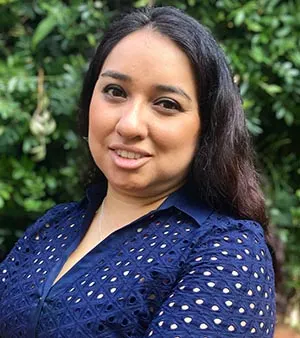
Claudia Gonzaga-Jauregui, PhD
One of Claudia’s first patient interactions was to communicate the result of a SYNGAP1 variant in a boy that had been a medical mystery for a long time:
I met the boy and his mom, and seeing the people behind the data I had analyzed in the lab — and the emotion of the mom when receiving the result of the genomic study, finally having an answer for her child after many years — was very meaningful and impactful. It emphasized how every genome that we analyze in the lab is, in reality, a person that is struggling with a disease and waiting for an answer.
Since leaving Baylor and returning to Mexico, Claudia has dedicated her career to the study and identification of novel genes responsible for rare genetic disorders, to provide answers to patients with undiagnosed diseases. For Claudia, connection and collaboration drive her rare disease work:
I think the rare disease community realized very early on that we needed to work together to find answers for our patients. … We had one patient with a very likely new disease gene, but we needed to find other patients to be sure. Finding the second or third or more patients for a completely new condition is motivating because it means that there are, and likely will be, more patients elsewhere in the world, and perhaps our findings and publications will help get those other patients diagnosed faster and open opportunities for therapy development.
Research on rare diseases
Claudia is one of dozens of authors whose work Elsevier has made freely available for 60 days beginning on Rare Disease Day February 28. Content includes Clinics review articles and articles and chapters in our books and journals, including the Cell Press portfolio — all intended to support researchers and clinicians in identifying the molecular basis of these diseases, advancing drug discovery and drug repurposing efforts, translating findings to the clinic, and counseling patients and families.
Articles from Elsevier’s Clinics and books detail a range of specific diseases, from rare congenital malformations to neurological disorders.
Rare diseases, by definition, affect a small number of individuals compared to the general population. In the United States, a disease is called rare if it affects fewer than 200,000 people at any given time. In Europe, the ratio is 1 affected person in 2,000. The total number of known, named rare diseases worldwide falls somewhere between 6,000 and 8,000 conditions. Although each individual disease is uncommon, their collective prevalence is estimated at 6 percent to 8 percent of the world population, implying that 450 million people have a rare disease.
In other words, rare diseases are not as rare as they seem.
“It always comes down to the human aspect.”
Dr Donald G Basel, Section Chief, Professor and Associate Director of the Undiagnosed & Rare Diseases, Genomic Sciences and Precision Medicine Center at Children’s Wisconsin, has been working in genetics for 22 years.
Regardless of whether conditions are obscure or occur more frequently, he said:
It always comes down to the human aspect — that connectedness where you feel the bond between patient and doctor and the ‘rightness’ of the research outcome that you know will drive future thinking.
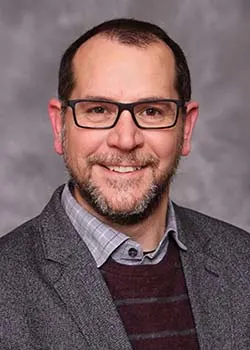
Donald G Basel, MD
Dr Basel and his mentor, Dr Robert Kliegman, Chair Emeritus of Pediatrics at the Medical College of Wisconsin and Editor of the Nelson Textbook of Pediatrics, are motivated by their mantra: “None of us are as smart as all of us.” It drives home that treating rare diseases is a team sport and everyone’s strengths contribute to the overall outcome of patients.
Further, this inter-connectedness of researchers and clinicians in the rare disease community plays a crucial part in ensuring access to medical evaluation.
Dr Brett J Bordini, a founding member of the Medical College of Wisconsin’s rare disease evaluation service along with Dr Kliegman, believes that the future of rare disease research and clinical care is going to require making sure that this wider availability is paired with a strong focus on equity in terms of access:
Enhanced broad network building paired with the ongoing development of localized evaluation teams can help ensure better equity with respect to diagnostic access and can ensure that everyone has an equal opportunity to attain diagnosis for their rare disorder.
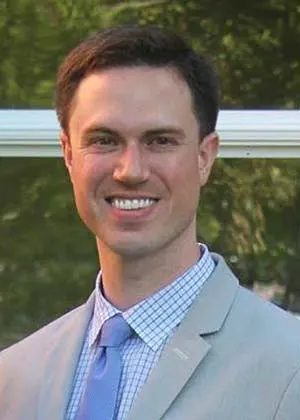
Brett Bordini, MD
About Rare Disease Day
Every year, the last day of February promotes awareness of rare diseases and the patients that suffer from them, as well as access to medical treatment and representation. Advocacy is critical for patients and their families. By improving disease understanding, connecting families with one another and with researchers, fundraising for research, or sharing resources, rare disease initiatives provide much needed support to patient communities. The National Organization of Rare Disorders, Perlara, the Rare Genomics Institute, the Iberoamerican Alliance for Rare Diseases and Global Genes are just a few organizations that have provided meaningful outcomes for patients and families. Meanwhile, Orphanet and NIH – GARD (Genetic and Rare Diseases Information Center) gather and share information on thousands of rare diseases, along with other resources, to improve diagnosis, care, and treatment.
Worldwide promotion of this event can be found via #RareDiseaseDay.
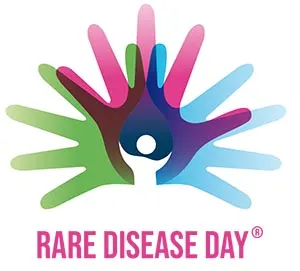
Free access to research on rare diseases
This content is freely available through April 30, 2022:
Book chapters
Claudia Gonzaga-Jauregui, Cinthya J. Zepeda Mendoza, Chapter 4 - Genomic Sequencing of Rare Diseases, Genomics of Rare Diseases (2021)
Robert Hegele, Chapter 7 - Lipoprotein and Lipid Metabolis, Emery and Rimoin's Principles and Practice of Medical Genetics and Genomics, 7e (2021)
Kevin C.J. Yuen, Albert Beckers, Chapter 4 - Acromegaly: Clinical Description and Diagnosis, Gigantism and Acromegaly (2021)
Robert J. Desnick, Manisha Balwani, Karl E. Anderson,Chapter 10 - Inherited Porphyrias, Emery and Rimoin's Principles and Practice of Medical Genetics and Genomics, 7e (2021)
Angela Sun, Irene J. Chang, Christina Lam, Gerard T. Berry,Chapter 14 - Lysosomal Storage Disorders, Emery and Rimoin's Principles and Practice of Medical Genetics and Genomics, 7e (2021)
Jennifer E. Posey, Chapter 9 - Multilocus Inheritance and Variable Disease Expressivity in Rare Disease, Genomics of Rare Diseases (2021)
Rossana L. Sanchez Russo, William R. Wilcox, Chapter 3 - Amino Acid Metabolism, Emery and Rimoin's Principles and Practice of Medical Genetics and Genomics, 7e (2021)
Bracha Erlanger Avigdor, Ikeoluwa A. Osei-Owusu, Jonathan Pevsner, Chapter 8 - Mosaicism in Rare Disease, Genomics of Rare Diseases(2021)
Thomas Liehr, Chapter 19 - Repetitive Elements, Heteromorphisms, and Copy Number Variants, Cytogenomics (2021)
Jerry Vockley, Chapter 8 - Organic Acidemias and Disorders of Fatty Acid Oxidation, Emery and Rimoin's Principles and Practice of Medical Genetics and Genomics, 7e (2021)
Erik G. Puffenberger, Chapter 5 - Recessive Diseases and Founder Genetics, Genomics of Rare Diseases (2021)
Priya S. Kishnani, Yuan-Tsong Chen, Chapter 4 - Disorders of Carbohydrate Metabolism, Emery and Rimoin's Principles and Practice of Medical Genetics and Genomics, 7e (2021)
Roberto Giugliani, Chapter 13 - Mucopolysaccharidoses, Emery and Rimoin's Principles and Practice of Medical Genetics and Genomics, 7e (2021)
Claudia Gonzaga-Jauregui, Lauretta El Hayek, Maria Chahrour, Chapter 6 - Dominant and sporadic de novo disorders, Genomics of Rare Diseases (2021)
Brianne B. Roby, Michael Broderick, Lauren A. Bohm, Chapter 11 - 22q11.2 Deletion Syndrome, Cummings Pediatric Otolaryngology, 2e (2021)
Filip Kucera, Chapter 11- Tetralogy of Fallot, Atlas of Pediatric Echocardiography(2021)
Federico G. Seifarth, Oliver S. Soldes,Chapter 25 - Congenital Anomalies and Surgical Disorders of the Stomach, Pediatric Gastrointestinal and Liver Disease, 6e (2021)
Roma Pradhan, Amit Agarwal, Celestino P. Lombardi, Marco Raffaelli, Chapter 2 - Applied Embryology of the Thyroid and Parathyroid Glands, Surgery of the Thyroid and Parathyroid Glands, 3e (2021)
David A. Zopf, Elizabeth Knecht, Jennifer Kim, Chapter 18 - Microtia Reconstruction, Cummings Pediatric Otolaryngology, 2e (2021)
Lisa M. Williams, Craig M. Mcdonald, Chapter 42 - Myopathic Disorders, Braddom's Physical Medicine and Rehabilitation, 6e (2021)
William Beau Mitchell, Christopher Walsh, Chapter 18 - Hemophilia, Atlas of Diagnostic Hematology(2021)
Walter L. Miller, Christa E. Flück, David T. Breault, Brian J. Feldman, Chapter 14 - The Adrenal Cortex and Its Disorders, Sperling Pediatric Endocrinology, 5e (2021)
David Coughlin, Andres Deik,Chapter 36 - Ataxia, Decision-Making in Adult Neurology (2021)
Joseph Jankovic, Mark Hallett, Michael S. Okun, Cynthia Comella, Stanley Fahn, Jennifer Goldman, Chapter 22 – Wilson Disease, Principles and Practice of Movement Disorders, 3e (2021)
Ronald P. Rapini, Chapter 2 - Eczematous and Papulosquamous Diseases, Practical Dermatopathology, 3e (2021)
Lindsay Montague, Ashley Clark, Jerry Elmer Bouquot, Chapter 4 – Lesions of the Oral Cavity, Gnepp's Diagnostic Surgical Pathology of the Head and Neck, 3e (2021)
Jay H. Lefkowitch, Chapter 5 – Biliary Disease, Scheuer's Liver Biopsy Interpretation, 10e (2021)
Doh Young Lee, Kwang Hyun Kim, Chapter 44 - Vascular Lesions of the Salivary Glands Surgery of the Salivary Glands(2021)
Clinics articles
Shiff NJ, Beukelman T: Pharmacosurveillance in Juvenile Idiopathic Arthritis. Rheumatic Disease Clinics (November 2021).
Politano SA, Colbert GB, Hamiduzzaman N: Nephrotic Syndrome. Primary Care: Clinics in Office Practice (December 2020).
Illig KA, Rodriguez-Zoppi E: How Common Is Thoracic Outlet Syndrome? Thoracic Surgery Clinics (February 2021).
Rubino M, Monda E, Lioncino M, et al: Diagnosis and Management of Cardiovascular Involvement in Fabry Disease. Heart Failure Clinics (January 2022).
Hasani N, Farhadi F, Morris MA, et al: Artificial Intelligence in Medical Imaging and its Impact on the Rare Disease Community: Threats, Challenges and Opportunities. PET Clinics (January 2022).
Patel SS: Pediatric Myelodysplastic Syndromes. Clinics in Laboratory Medicine (September 2021).
Elghetany MT, Punia JN, Marcogliese AN: Inherited Bone Marrow Failure Syndromes: Biology and Diagnostic Clues. Clinics in Laboratory Medicine (September 2021).
Johannson KA, Collard HR, Richeldi L: Looking Ahead: Interstitial Lung Disease Diagnosis and Management in 2030. Clinics in Chest Medicine (June 2021).
Krieger EV, Valente AM: Tetralogy of Fallot. Cardiology Clinics (August 2020).
Hatamizadeh P: Cardiorenal Syndrome: An Important Subject in Nephrocardiology. Cardiolology Clinics(August 2021).
Saponaro F: Rare Causes of Hypercalcemia. Endocrinology and Metabolism Clinics of North America (December 2021).
Tremblay D, Yacoub A, Hoffman R: Overview of Myeloproliferative Neoplasms: History, Pathogenesis, Diagnostic Criteria, and Complications.Hematology/Oncology Clinics of North America (April 2021).
Langer AL, Connell NT: Acquired von Willebrand Syndrome. Hematology/Oncology Clinics of North America (December 2021).
Pai M: Acquired Hemophilia A. Hematology/Oncology Clinics of North America (December 2021).
Varagur K, Sanka SA, Strahle JM: Syndromic Hydrocephalus. Neurosurgery Clinics of North America
(January 2022).
Hersh DS, Hughes CD: Syndromic Craniosynostosis: Unique Management Considerations.
Neurosurgery Clinics of North America (January 2022).
Fusco A, Mauriello A, Lioncino M, et al: The Heart Muscle and Valve Involvement in Marfan Syndrome, Loeys-Dietz Syndromes, and Collagenopathies. Heart Failure Clinics (January 2022)
Crillo A, Lioncino M, Maratea A, et al: Clinical Manifestations of 22q11.2 Deletion Syndrome. Heart Failure Clinics 18 (January 2022).
Baban A, Lodato V, Parlapiano G, et al: Genetics in Congenital Heart Diseases: Unraveling the Link Between Cardiac Morphogenesis, Heart Muscle Disease, and Electrical Disorders.
Heart Failure Clinics (January 2022).
Citro R, Radano I, Bellino M, et al: Epidemiology, Pathogenesis, and Clinical Course of Takotsubo Syndrome. Heart Failure Clinics (January 2022).
Cell Press journal articles
MED
Frazier et al, Fatal Perinatal Mitochondrial Cardiac Failure Caused by Recurrent De Novo Duplications in the ATAD3 Locus ,Med (January 2021)
Ejaz et al, Long-Term Patient-Customized Therapy for a Pathogenic EPO Mutation, Med (January 2021)
Cell
Misteli, Farnesyltransferase inhibition in HGPS, Cell (January 2021)
Béziat et al., Humans with inherited T cell CD28 deficiency are susceptible to skin papillomaviruses but are otherwise healthy, Cell (July 2021)
Rosat Consiglio et al. The Immunology of Multisystem Inflammatory Syndrome in Children with COVID-19,Cell (November 2020)
Yu et al. Cranial Suture Regeneration Mitigates Skull and Neurocognitive Defects in Craniosynostosis, Cell (January 2021)
Trends journals
Rieckher et al, Molecular pathology of rare progeroid diseases, Trends in Molecular Medicine
(September 2021)
Belver et al, Deregulation of enhancer structure, function, and dynamics in acute lymphoblastic leukemia, Trends in Immunology (May 2021)
Ortiz-Cordero et al, Fukutin-Related Protein: From Pathology to Treatments - ScienceDirect, Trends in Cell Biology (March 2021)
Roessler et al, Drug Repurposing for Rare Disease, Trends in Pharmacological Sciences (April 2021)
Martin et al, Multiple sclerosis: doubling down on MHC, Trends in Genetics (September 2021)

